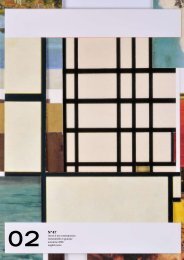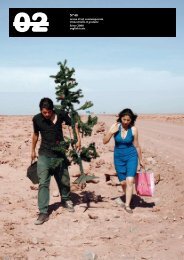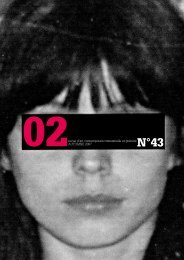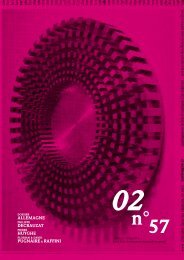par Céline Chazalviel
par Céline Chazalviel
par Céline Chazalviel
You also want an ePaper? Increase the reach of your titles
YUMPU automatically turns print PDFs into web optimized ePapers that Google loves.
58<br />
GUEST<br />
page précédente<br />
Ulla von Brandenburg<br />
Curtain II 2008<br />
Peinture sur tissus/Paint on fabric<br />
Vue de l’exposition/Exhibition view of Name or Number,<br />
Frac Ile-de-France / Le Plateau, 2009<br />
Courtesy Produzentengalerie (Hambourg), Galerie Pilar Corrias<br />
Ltd (Londres), Galerie art:concept (Paris)<br />
Photo Martin Argyroglo<br />
En franchissant le rideau qui constitue l’entrée<br />
de Name or Number, la récente exposition de<br />
Ulla von Brandenburg au Plateau à Paris 1 , on<br />
ne peut s’empêcher de se remémorer ce fameux<br />
passage de Shakespeare : « Le monde entier<br />
est un théâtre / Et tous, hommes et femmes,<br />
n’en sont que les acteurs / Ils ont leurs sorties<br />
comme leurs entrées » 2 .<br />
Le passage de ce rideau, aux motifs de costume<br />
d’Arlequin (Curtain II, 2008) est une évocation<br />
de la métaphore du Theatrum Mundi, selon<br />
laquelle les êtres jouent tous, consciemment<br />
ou non, un rôle sur la scène d’un monde<br />
perçu comme jeu ou représentation, et dont<br />
les ficelles sont tirées <strong>par</strong> le démiurge de<br />
l’œuvre qu’est la réalité ou sa mise en abyme<br />
fictionnelle. Le comédien, et le personnage qu’il<br />
incarne, reflètent l’image même du spectateur<br />
leurré, déjà acteur de l’univers. Cette illusion,<br />
et la tension latente de sa révélation, sont<br />
synthétisées dans l’effet miroir que propose la<br />
peinture murale Publikum (Audience, 2008).<br />
Cette peinture, placée vers la fin du <strong>par</strong>cours<br />
de l’exposition du Plateau, représente les<br />
spectateurs d’un théâtre fixant la scène, leur<br />
visage fantomatique se découpant dans un<br />
fort effet négatif sur un fond orange.<br />
Si le concept de Theatrum Mundi a connu son<br />
ci-dessus<br />
Quilt III 2008<br />
8 vestes, 8 cravates sur socle en bois/8 jackets, 8 ties on a wooden<br />
base. 3,67 x 6, 65 m. Vue de l’exposition/Exhibition view of Name<br />
or Number, Frac Ile-de-France / Le Plateau, 2009. Courtesy<br />
Produzentengalerie (Hambourg), Galerie Pilar Corrias Ltd<br />
(Londres), Galerie art:concept (Paris)<br />
Photo Martin Argyroglo<br />
apogée avec le baroque, l’univers scénique de<br />
Ulla von Brandenburg est un collage complexe<br />
d’éléments visuels créant une atmosphère<br />
sophistiquée et anxieuse de « fin de siècle ».<br />
Ce mouvement culturel de la fin du XIX e siècle<br />
anticipait les changements imminents de la<br />
modernité. Loin d’être empreint de nostalgie,<br />
le travail d’Ulla von Brandenburg examine<br />
notre contemporain à l’aune des peurs et<br />
des émotions intemporelles d’époques, où la<br />
recherche scientifique n’était pas sé<strong>par</strong>ée de<br />
la spiritualité et où les mécanismes, derrière<br />
les innovations technologiques, semblaient<br />
mystérieux et envoûtants. Ainsi, le monde<br />
de l’artiste est peuplé de fantômes, d’acteurs,<br />
d’adeptes du spiritisme ou de magie, et de<br />
personnages silencieux et figés tout droit sortis<br />
du théâtre d’Anton Tchekhov ou d’August<br />
Strindberg. Ce carnaval de dandies et de<br />
femmes affectées prend la pose dans des<br />
tableaux vivants que l’artiste filme le temps<br />
d’une pellicule Super 8 ou 16mm. Silencieux,<br />
ces films en noir et blanc sont d’environ trois<br />
minutes et tournent en boucle. Les quelques<br />
oscillations souvent dues à la respiration<br />
des acteurs révèlent un jeu avec la notion<br />
d’instantané, dans une mise en <strong>par</strong>allèle<br />
critique du tableau vivant, des premiers<br />
développements de la photographie (le temps<br />
d’exposition) et de la peinture. Des films<br />
courts, jusqu’aux films plus récents possédant<br />
des travellings complexes comme 8 (2007)<br />
et Singspiel (2009), on retrouve toujours un<br />
catalogue de poses et de situations dont les<br />
dessins et peintures de l’artiste se font l’écho :<br />
le motif du visage caché dans les mains, celui<br />
du baiser, de l’alitement, du jeu de cartes, etc.<br />
Il est <strong>par</strong>fois possible d’identifier des sources<br />
historiques, comme la nature caravagesque du<br />
jeu de cartes, cependant l’intensité dramatique<br />
de ces corps pétrifiés peut également se lire<br />
en lien à la modernité des gestes réduits,<br />
répétitifs et rituels des chorégraphies d’Yvonne<br />
Rainer ou de Hannah Halprin. L’artiste pose<br />
donc la question du mouvement et de la<br />
performativité des non-dits, en écho aux écrits<br />
de Goethe (et bien plus tard de Tchekhov),<br />
qui tentant de réduire le jeu de l’acteur à un<br />
ensemble de poses et de gestes, prescrivait<br />
une mobilité réduite pour les personnages<br />
importants 3 .<br />
Après avoir étudié la scénographie à Karlsruhe<br />
et travaillé dans le théâtre, Ulla von Brandenburg<br />
a intégré l’école d’art de Hambourg,<br />
dans l’atelier de Cosima von Bonin et elle<br />
utilise comme celle-ci une grande variété<br />
de médias (peinture, dessin, sculpture, film<br />
Publikum 2008<br />
Peinture murale à l’acrylique/Acrylic on wall<br />
Vue de l’exposition/Exhibition view of Name or Number, Frac Ile-de-France / Le Plateau, 2009<br />
Courtesy Produzentengalerie (Hambourg), galerie Pilar Corrias Ltd (Londres), galerie art:concept<br />
(Paris). Photo Martin Argyroglo<br />
As we pass through the curtain constituting<br />
the entrance of Name or Number 1 , Ulla<br />
von Brandenburg’s recent exhibition at the<br />
Plateau in Paris, we cannot help recalling<br />
Shakespeare’s famous words: “All the world’s<br />
a stage/ And all the men and women merely<br />
players/ They have their exits and their<br />
entrances.” 2<br />
Our passage through this curtain (Curtain II,<br />
2009) , decorated in the image of a Harlequin’s<br />
livery, is an evocation of the Theatrum Mundi<br />
metaphor, which holds that, consciously<br />
or not, all human beings play a role on the<br />
stage of the world, perceived as a game or<br />
representation and governed by its creator:<br />
reality, or its fictional mise en abyme. The actor,<br />
and the character he incarnates, reflects<br />
the image of the deluded spectator, himself<br />
an actor in the universe. This illusion, and<br />
the latent tension of its potential disclosure,<br />
are fused in the mirror effect in the 2008<br />
wall-painting Publikum (Public). Stationed<br />
toward the end of our itinerary through the<br />
Plateau exhibition, this painting portrays the<br />
spectators of a theater staring at the stage,<br />
their ghostly faces cut in negative against<br />
an orange background.<br />
Although the Theatrum Mundi concept<br />
achieved its apogee in the baroque, Ulla<br />
von Brandenburg’s theatrical universe, a<br />
complex collage of visual elements, creates<br />
more of a “fin de siècle” atmosphere,<br />
sophisticated and anxiety-filled. At the turn<br />
of the 19 th century, this cultural movement<br />
anticipated the imminent changes that<br />
modernity would bring. Far from create an<br />
imprint of nostalgia, Ulla von Brandenburg<br />
examines the contemporary through the<br />
timeless fears and emotions we associate<br />
with that earlier era, when scientific research<br />
was not se<strong>par</strong>ate from spirituality, and the<br />
mechanisms of technological innovation,<br />
still mysterious and bewitching. The artist’s<br />
world is populated by ghosts, actors, disciples<br />
of magic and spiritualism, silent and frozen<br />
characters straight out of an Anton Chekhov<br />
or August Strindberg play. This carnival of<br />
dandies and mannered women pose in the<br />
tableaux vivants the artist films over the<br />
duration of a roll of Super 8 or 16mm. Silent,<br />
these black and white shorts last about three<br />
minutes and are repeated on loop. Small<br />
oscillations, often due to breathing, reveal,<br />
via a <strong>par</strong>allel critique of the tableau vivant,<br />
a play with the notion of the instantaneous<br />
in the early developments of photography<br />
(shutter speed) and painting. Beginning<br />
with these short films and continuing on to<br />
more recent ones like 8 (2007) and Singspiel<br />
(2009), we discover a catalogue of poses and<br />
situations, echoed in the artist’s drawings<br />
and paintings: the motif of a face hidden by<br />
hands, of a kiss, a bedridden figure, a game<br />
of cards. Sometimes it is possible to identify<br />
their historical sources: the Caravaggesque<br />
nature of a game of cards, for example, even<br />
as the dramatic intensity of these petrified<br />
bodies simultaneously recalls a modernity<br />
of reduced, repetitive, and ritual gestures<br />
à la Yvonne Rainer or Hannah Halprin.<br />
The artist asks, then, the question of the<br />
movement and performativity of what is left<br />
unsaid, echoing the writings of Goethe (and<br />
much later on, Chekhov), which attempted<br />
to reduce the art of acting to an ensemble<br />
of poses and gestures, stipulating a reduced<br />
mobility for the lead roles. 3<br />
After studying set design in Karlsruhe and<br />
working in theater, Ulla von Brandenburg<br />
entered the art school of Hamburg under<br />
the tutelage of Cosima von Bonin, and, like<br />
her teacher, worked across a wide range of<br />
media: painting, drawing, sculpture, film,<br />
and performance. Each work functions as<br />
59<br />
GUEST







